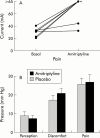Centrally acting agents and visceral sensitivity
- PMID: 12077076
- PMCID: PMC1867729
- DOI: 10.1136/gut.51.suppl_1.i91
Centrally acting agents and visceral sensitivity
Abstract
The evidence relating to the site and mechanism of action of "centrally acting" agents which may affect visceral sensitivity is reviewed. Antidepressant drugs such as amitriptyline as well as the newer selective serotonin reuptake inhibitors are thought to act at the level of the CNS. Opiates, including morphine as well as compounds such as trimebutine or fedotozine designed for therapeutic use in irritable bowel syndrome, are effective in reducing visceral nociception. Cytokines in the CNS are known to be involved in the modulation of pain and there is also evidence to suggest that centrally acting cytokines may play a role in the production of visceral hypersensitivity. Consequently, they may provide an interesting target for future research.
Figures



Similar articles
-
Pharmacotherapy: non-serotonergic mechanisms.Gut. 2002 Jul;51 Suppl 1(Suppl 1):i87-90. doi: 10.1136/gut.51.suppl_1.i87. Gut. 2002. PMID: 12077075 Free PMC article. Review.
-
Serotonergic modulation of visceral sensation: lower gut.Gut. 2002 Jul;51 Suppl 1(Suppl 1):i81-6. doi: 10.1136/gut.51.suppl_1.i81. Gut. 2002. PMID: 12077074 Free PMC article. Review.
-
Role of visceral sensitivity in the pathophysiology of irritable bowel syndrome.Gut. 2002 Jul;51 Suppl 1(Suppl 1):i67-71. doi: 10.1136/gut.51.suppl_1.i67. Gut. 2002. PMID: 12077070 Free PMC article. Review.
-
Serotonergic modulation of visceral sensation: upper gastrointestinal tract.Gut. 2002 Jul;51 Suppl 1(Suppl 1):i77-80. doi: 10.1136/gut.51.suppl_1.i77. Gut. 2002. PMID: 12077073 Free PMC article. Review.
-
[Visceral hypersensitivity: a concept within our reach].Rev Med Chil. 2003 Jan;131(1):85-92. Rev Med Chil. 2003. PMID: 12643225 Review. Spanish.
Cited by
-
Protective effect of huoxiang zhengqi oral liquid on intestinal mucosal mechanical barrier of rats with postinfectious irritable bowel syndrome induced by acetic Acid.Evid Based Complement Alternat Med. 2014;2014:218383. doi: 10.1155/2014/218383. Epub 2014 Aug 28. Evid Based Complement Alternat Med. 2014. PMID: 25254052 Free PMC article.
-
Low-dose naltreoxone for the treatment of irritable bowel syndrome: a pilot study.Dig Dis Sci. 2006 Dec;51(12):2128-33. doi: 10.1007/s10620-006-9289-8. Epub 2006 Nov 1. Dig Dis Sci. 2006. PMID: 17080248 Clinical Trial.
-
Safety and tolerability of low-dose naltrexone therapy in children with moderate to severe Crohn's disease: a pilot study.J Clin Gastroenterol. 2013 Apr;47(4):339-45. doi: 10.1097/MCG.0b013e3182702f2b. J Clin Gastroenterol. 2013. PMID: 23188075 Free PMC article. Clinical Trial.
-
Treatment of functional dyspepsia with sertraline: a double-blind randomized placebo-controlled pilot study.World J Gastroenterol. 2012 Nov 14;18(42):6127-33. doi: 10.3748/wjg.v18.i42.6127. World J Gastroenterol. 2012. PMID: 23155342 Free PMC article. Clinical Trial.
-
Antispasmodics for Chronic Abdominal Pain: Analysis of North American Treatment Options.Am J Gastroenterol. 2021 Aug 1;116(8):1587-1600. doi: 10.14309/ajg.0000000000001266. Am J Gastroenterol. 2021. PMID: 33993133 Free PMC article. Review.
References
Publication types
MeSH terms
Substances
LinkOut - more resources
Full Text Sources
Medical
